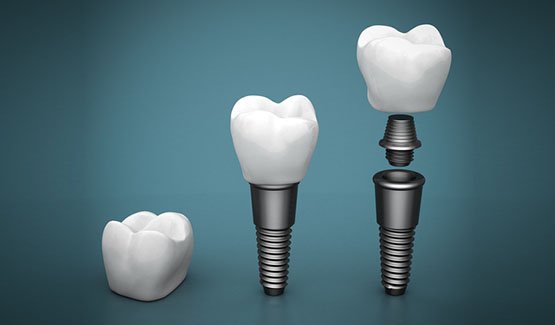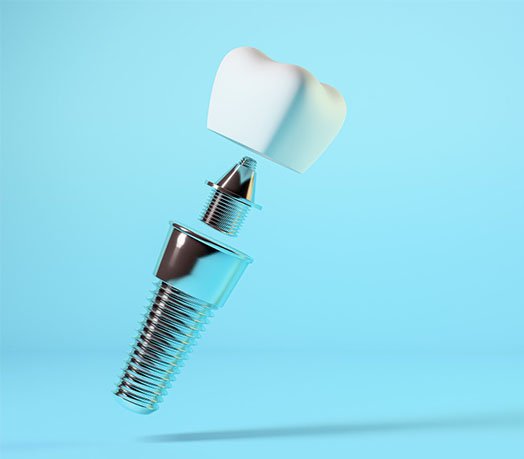Dental Implants
High-Quality Dental Implants in Canley Heights
Dental Implants Canley Heights
Dental implants are appliances that aim to restore missing teeth so you can achieve a complete, healthy smile.

A dental implant is a surgical unit that interfaces with the jawbone or skull to support and hold up a dental prosthesis such as a crown, bridge, denture, facial prosthesis or to act as an orthodontic anchor.
Also, this is the procedure of replacing the root of the missing tooth.
They help and allow you to live the way you want and confidently eat, smile, talk, kiss, and enjoy all of your everyday activities without worrying about your teeth.
Components of Dental Implants
There are three components of dental implants: body, abutment and the porcelain crown.
Take a look at each component and their functions in the dental implant procedure.
The body. The body is made from titanium, the same sort of expensive material that aircraft and ships are made of. It is used for dental implants because it’s lightweight and extraordinarily durable.
And also, it is known for biocompatibility, meaning it is rarely rejected by the human body. This implant is placed into the gum where the tooth is missing during a short surgical process. It’s open cylindrical and resembles a screw.
The abutment. It is usually made out of porcelain, gold, or titanium.
This procedure is joined with the implant with a screw it is cut so that it resembles a natural and look like a tooth in order for the crown to fit on top of it.
The crown. Also called the restoration, the crown is the part of a dental implant that looks like a natural tooth. Usually, the crown is either cemented or screwed on the abutment.
If the abutment and the crown are screwed together, a composite material will usually be placed on top of the screw hole to create a natural look.
Types of Dental Implants
There are three types of dental implants: Endosteal, Subperiosteal and Zygomatic implants.
Endosteal implants
These implants are the most common types because they are suitable for most patients, but they require a good, healthy jawbone for the post to fuse to.
A placeholder post is shaped like screws. It is placed into the jaw that the false teeth are fitted on.
When the procedure is done, healing period may take a week or two. It requires the time to fuse together and create a strong hold. Once it has fully healed, the false teeth can be placed on the post to fit in with the surrounding teeth.
However, you don’t like this idea that something is placed on your jawbone, you might like the second common types of implant a little more.
Subperiosteal implants
This type of dental implants is the main alternative to endosteal implants. This implant is rest on top of the bone but still under the gum, unlike to the endosteal that fixed into the jawbone.
A metal frame is placed under the gum with post attached then heals around the frame to hold it in place, and the false teeth are secured to the poles that come from the gum.
This procedure is applicable for patients who don’t have enough jawbone for an implant to be placed or if the person has a history of intensive oral surgery to add bone to the area.
Zygomatic implants
This is the least common type among the rest of the dental implants that is available for you and this is the most complicated procedure and should only be done if you don’t have enough jawbone for the endosteal implants.
This implant is placed into the patient’s cheekbone.

Dental Implants: How do they work?
To place a dental implant, a small incision is made in the soft tissue gum to access the bone — preparation with the use of special drills.
The titanium implant is placed onto the jawbone, and the gum stitched over and the implant allowed to fuse to the bone undisturbed.
The second phase is usually started after 4 to 6 months, where if necessary, the dental implant/s are exposed and healing caps or temporary gum forming restorations attached.
Following tissue healing within 2-4 weeks, final impressions are made, and the final definitive prosthetic replacements attached.
Regular visits at 4-6-week intervals during healing are necessary to review and keep a check on the healing, and also once the final restorations have been fitted, on a 3-monthly basis.
Dental Implants in Canley Heights
If you have one or more teeth that are worn, damaged, or infected by a cavity, Canley Heights Dental Care can fix it with custom-made, lifelike dental restorations, like dental implants.
Visit your Canley Heights dentist today!
If you want to know more about our dental implants in Canley Heights, please call us on (02) 9199 9678 or book your appointment online.
We are located at 1/229 Canley Vale Road in Canley Heights.

Frequently Asked Questions
What is the importance of dental implants?
Improve your appearance. It is fitted to your jawbone, making your smile look better.
Improve your speech. Compared to when you have missing teeth, speaking becomes easier and more audible.
Helps to eat easier. You can chew whatever you like and allows you to eat your favourite food.
Improve your self-esteem. Dental implants feel like your own teeth. You can confidently smile again.
Durability. Dental implants can last for many years, and with good care, it will last for a lifetime.
